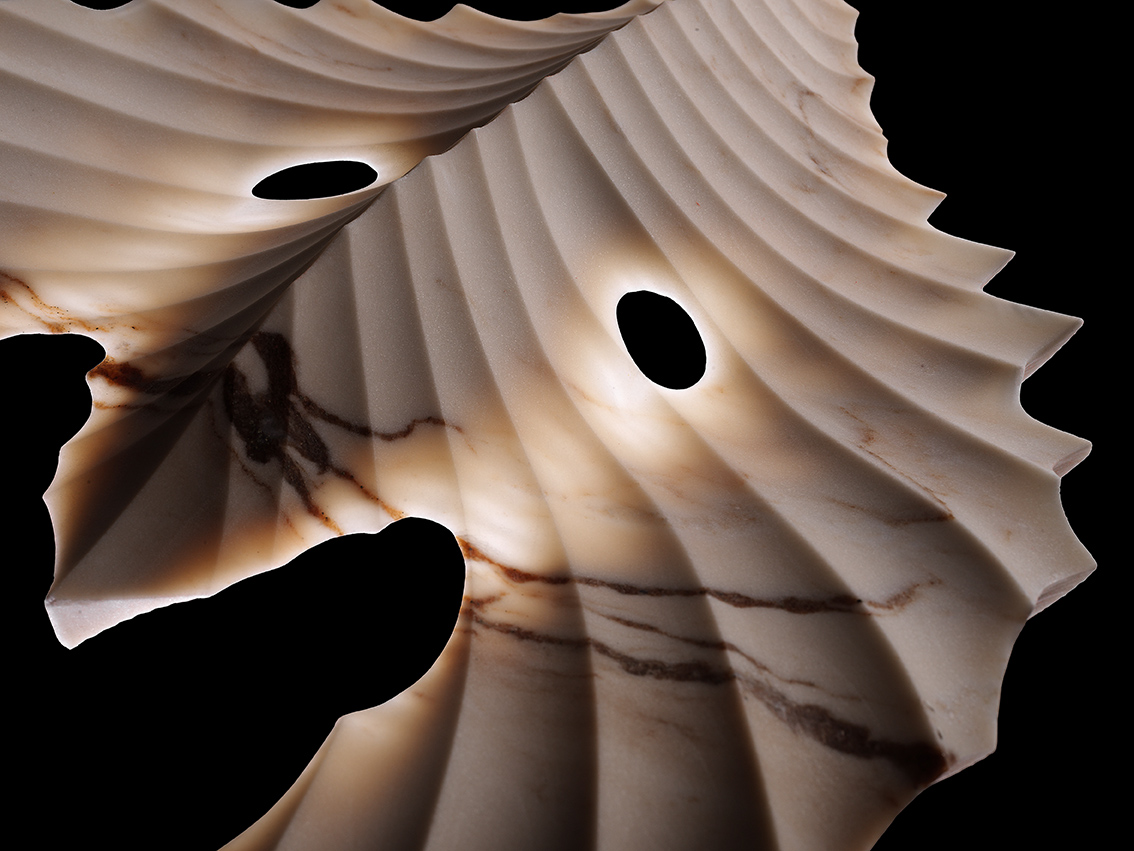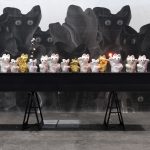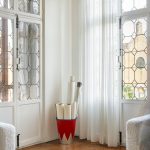Scroll down for English version
Raffaello Galiotto, designer e artista. Formatosi all’Accademia di Belle Arti di Venezia ha da sempre dimostrato un animo e una necessità espressiva da artista conducendo una carriera di successo nel mondo del design. Artefacta Lapis, è la somma di tutte le competenze e passioni coltivate nell’arco della carriera. Più che una mostra, la possiamo intendere un’esperienza artistica tutto tondo in cui da creativo si trasforma in creatore di sculture che rappresentano un copro a corpo tra il marmo e la tecnologia.
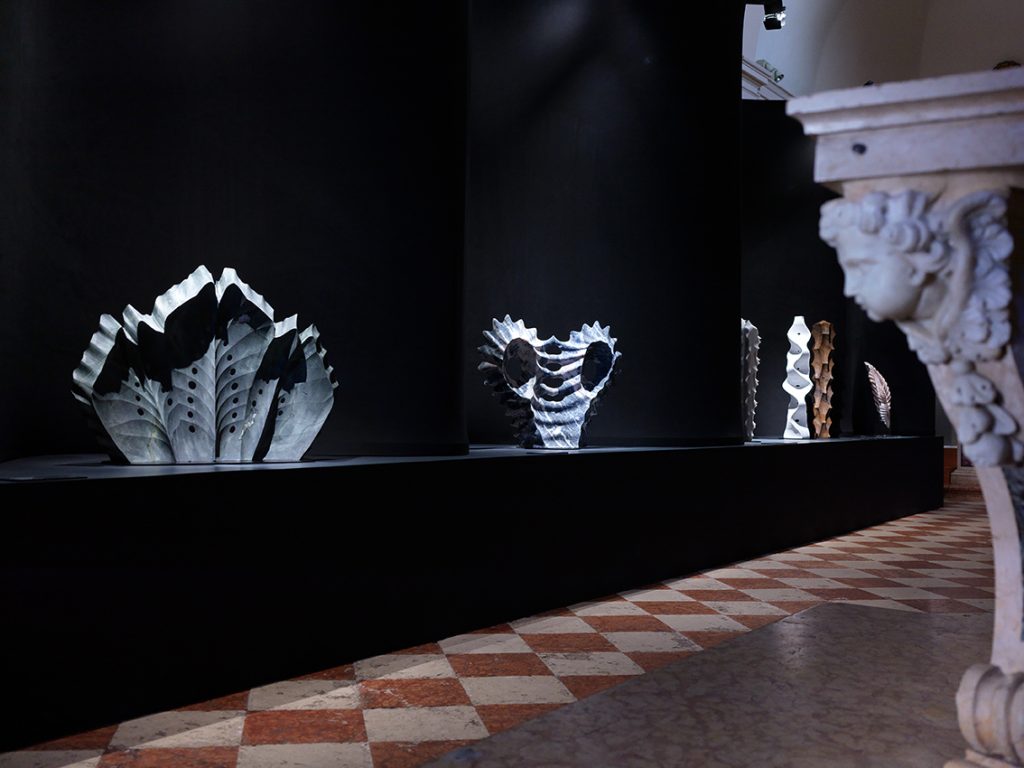
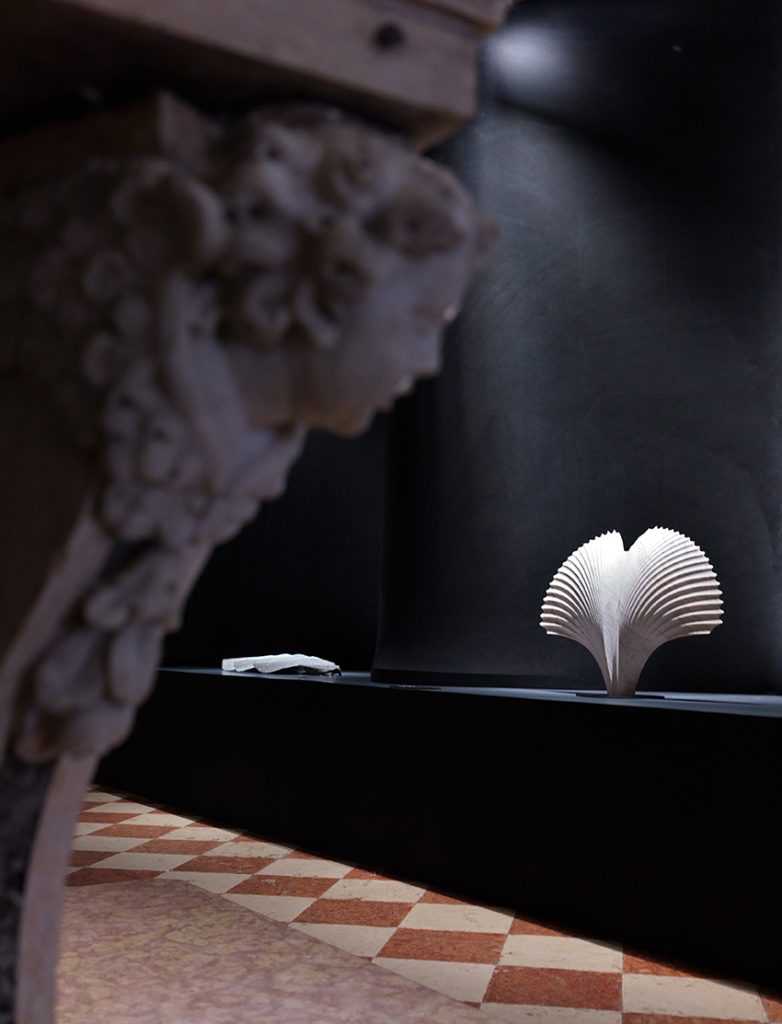
Mostra “ARTEFACTA LAPIS” di Raffaello Galiotto, ex-chiesa di San Pietro in Monastero, Verona, ottobre 2024 © Raffaello Galiotto
Cosa rappresenta per Lei Artfacta Lapis?
Artefacta Lapis è la tappa più recente di un lungo percorso di ricerca espressiva sul marmo che ho condotto mediante l’impiego di strumentazioni computerizzate.
Non si tratta semplicemente di produrre opere con i robot ma di utilizzare le peculiarità di questi dispositivi software già in fase creativa espandendo l’immaginazione, tenendo simultaneamente in considerazione le modalità esecutive delle macchine e portando a finitura l’opera senza successivi interventi manuali. Non c’è dubbio che anche nell’arte l’impiego di questi potenti mezzi apre nuovi scenari, preludio di nuove opportunità creative.
Sorge spontaneo chiedere da dove derivi il fascino per il marmo, così profondo, da farlo diventare elemento primario della sua produzione artistica.
Sono cresciuto nella Valle del Chiampo in provincia di Vicenza, un territorio tradizionalmente noto per la lavorazione del marmo, pertanto per me questa materia ha un sapore familiare. In realtà non ho compreso subito la potenza della pietra ma più tardi, in età più matura. Se solo si comprende che il marmo è una materia naturale formatasi in milioni di anni, potremmo leggere nelle tessiture e nelle infinite variazioni cromatiche le fasi primordiali del nostro pianeta.
Disporre di questa materia antichissima e poterla lavorare è per me un vero privilegio, ed è questo il motivo per cui è diventato l’elemento primario della mia produzione artistica.
Il confronto fra arte e tecnologia è una tematica che appartiene da lungo tempo alla storia dell’arte. Pensando fra tutti a Walter Benjamin e Marshall McLuhan sappiamo che ci sono stati importanti contributi e riflessioni sulla decodifica del rapporto mutevole tra arte, tecnologia e società. Qual’è la sua posizione riguardo a questo tema, esplicitata proprio nel suo lavoro scultoreo? Come vive il rapporto tra arte e tecnologia?
La tecnologia è un mezzo, come lo sono stati gli strumenti primordiali con cui l’umanità ha cercato di lavorare le pietre dure. Poi lo scalpello si è evoluto fino a diventare un utensile guidato da software e dispositivi di precisione a controllo numerico. Per me l’impiego della tecnologia è una questione superata. Piuttosto, trovo ancora misteriosa e sorprendente la risposta mutevole e inattesa della materia litica sottoposta alle diverse lavorazioni. Ed è inoltre interessante notare che nelle opere in pietra naturale, “l’aura” dell’opera, ben descritta da Water Benjamin nel suo saggio “L’opera d’arte nell’epoca della sua riproducibilità tecnica”, venga preservata anche nel caso della produzione seriale automatica perché, in qualche modo, è in grado di essere generata dalla materia litica in quanto essa stessa irripetibile, autentica, e non solo dall’unicità determinata dalla mano dell’artista.
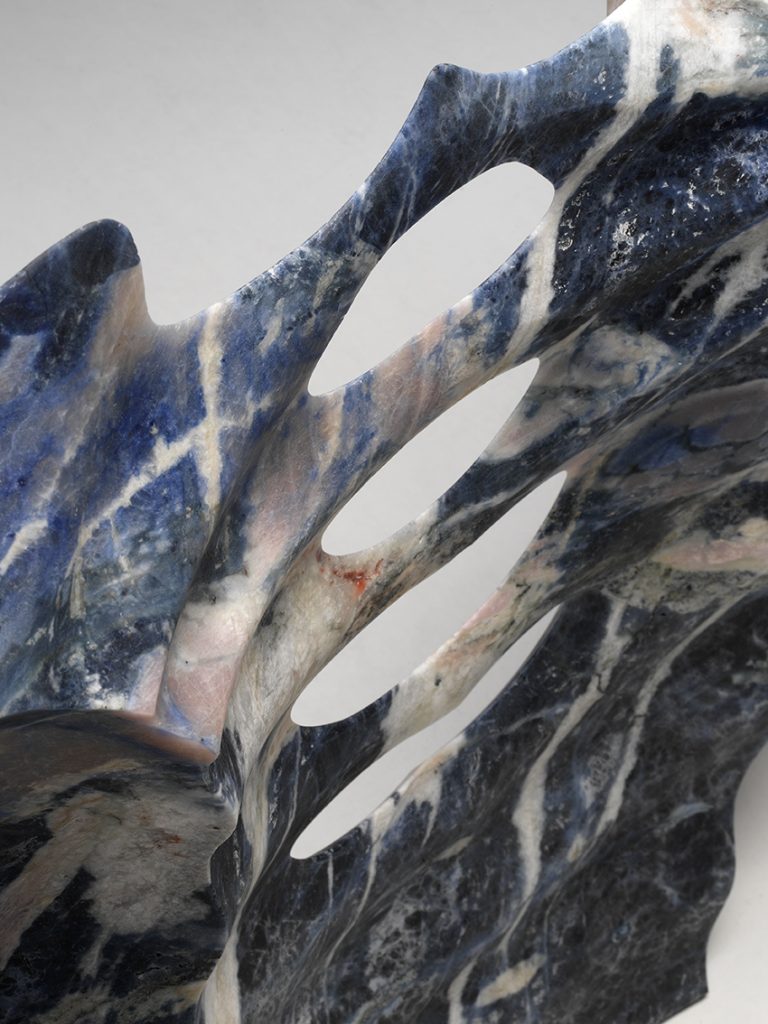
“Quercus”, 2023. Amazzonite marble, 90 x 62 x 11 cm © Raffaello Galiotto
Le sue opere riescono a comunicare leggerezza, delicatezza e grazia pur utilizzando un materiale pesante e di difficile lavorazione. Ci può raccontare l’intero processo, dalla scelta del marmo alla sua lavorazione millimetrica e guidata da lei in ogni passaggio, fino al risultato desiderato?
Ogni opera nasce da un intento preciso. E ogni opera, sia nella fase creativa-progettuale che esecutiva, deve fare i conti con i limiti e le caratteristiche della materia e delle tecniche di lavorazione. Amo osservare le strutture degli esseri animali e vegetali e da queste cerco di capire anche con stupore e una buona dose di incomprensibilità le logiche strutturali e di crescita. Intuire come lo scheletro sorregge il corpo o la foglia si dispone sul ramo, mi aiuta a dare forma e a strutturare le opere secondo un senso, togliendo il superfluo e contemporaneamente a definire la logica di come le si realizza. I limiti realizzativi talvolta limitano le forme e mi costringono a ripensarle per poi ancora ritornare a ritoccarle attraverso un andirivieni continuo fino a trovare la soluzione. Questo processo di scarto, di ottimizzazione, tra la forma iniziale e la forma possibile, è un processo direi naturale, selettivo, tant’è vero che in natura niente è per caso e ogni parte dipende dall’altra.
Se intendiamo il suo un corpo a corpo con la tecnologia, ci sono dei risultati che ambisce raggiungere ma che la tecnologia non è ancora in grado di portare? Quanta ricerca tecnologica è insita nella realizzazione di una sua scultura?
Queste opere sono sempre il risultato di un compromesso. I limiti tecnologici sono moltissimi come altrettanto numerose sono le sfide da superare. Non c’è opera che sia semplice, ogni volta c’è un problema nuovo, ora la modellazione 3d, poi la gestione dei movimenti macchina, le collisioni meccaniche, la funzionalità degli utensili e non ultimo la risposta della materia. Siamo solo all’inizio di un’epoca nuova.
Alfonso Cariolato ha curato il testo del catalogo e la mostra. Una collaborazione che ha dato risultati di grande valore. Quanto reputa importante un confronto intellettuale e una lettura esterna delle sue opere?
Il confronto, il dialogo, soprattutto con l’esterno sono molto importanti. Quando si lavora lungamente e incessantemente su un argomento si rischia la deriva senza neanche accorgersene. L’apporto intellettuale esterno, se onesto e diretto, può essere graffiante quando evidenzia le criticità ma al contempo ti fa crescere e ti indirizza nel verso giusto.
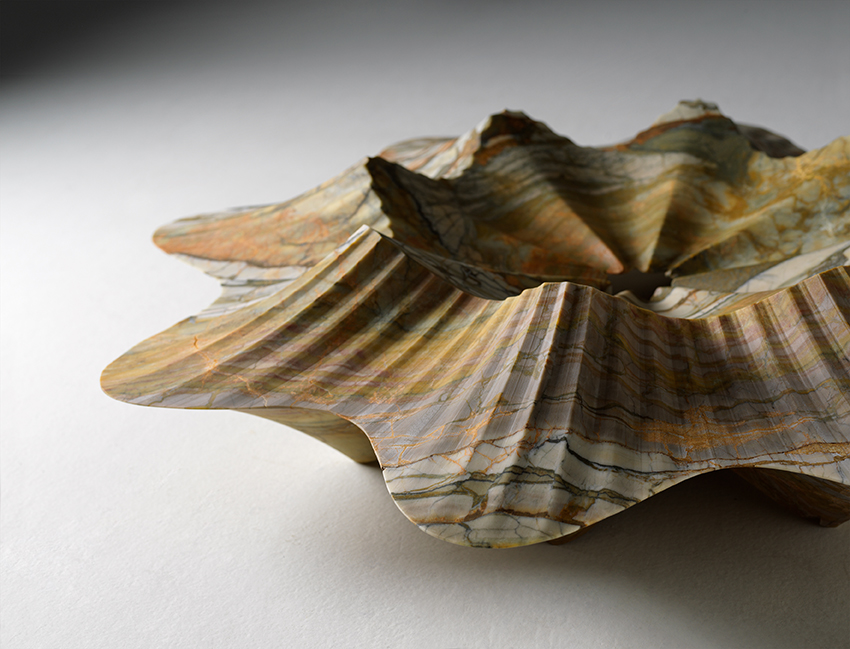
“Valvatida”, 2023. Pocahontas marble, 64 x 64 x 14 cm © Raffaello Galiotto
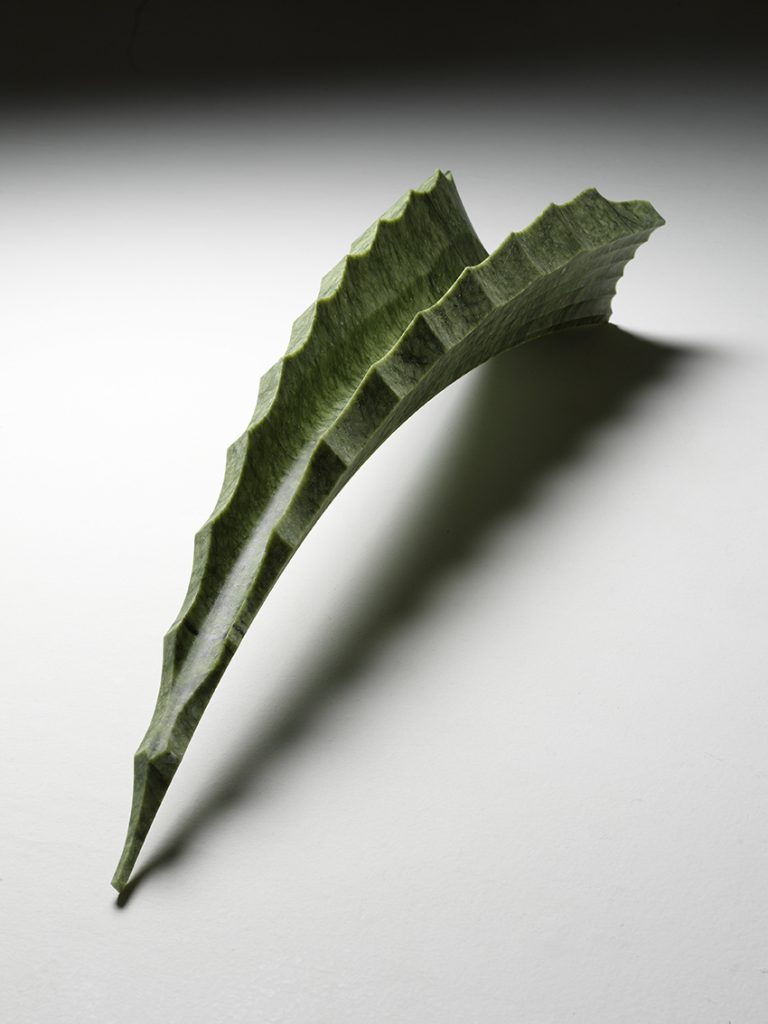
“Aloacea”, 2023. Verde Giada marble, 97 x 22,5 x 18,5 cm © Raffaello Galiotto
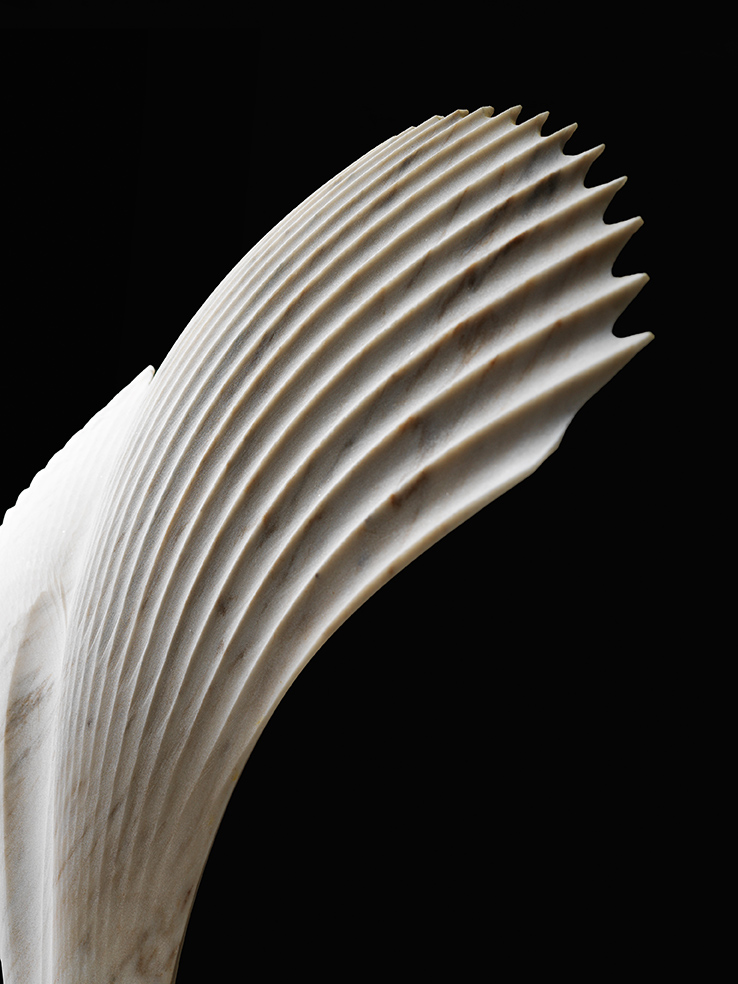
“Biloba”, 2023. Palissandro Reale marble , 92 x 13 x 58 cm © Raffaello Galiotto
Raffaello Galiotto has always displayed the soul of an artist and the need to express himself. After training at the Academy of Fine Arts in Venice, he pursued a successful career in the world of design. Artefacta Lapis is the summation of all the skills and passions he cultivated throughout his professional life. More than a simple exhibition, it is an all-round artistic experience in which he transforms himself from a creative into a creator of sculptures that represent a merging of marble and technology.
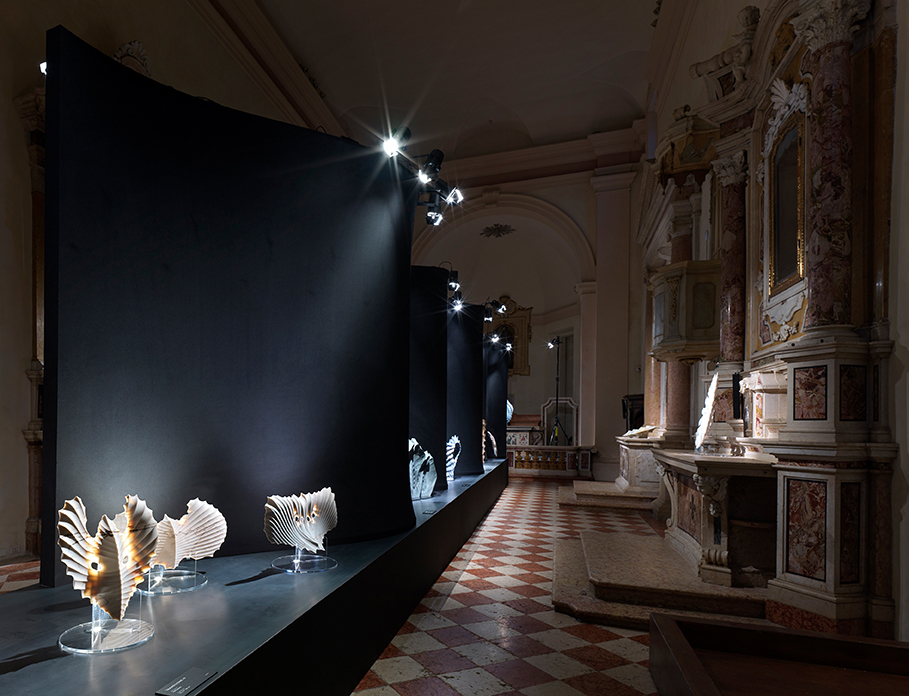
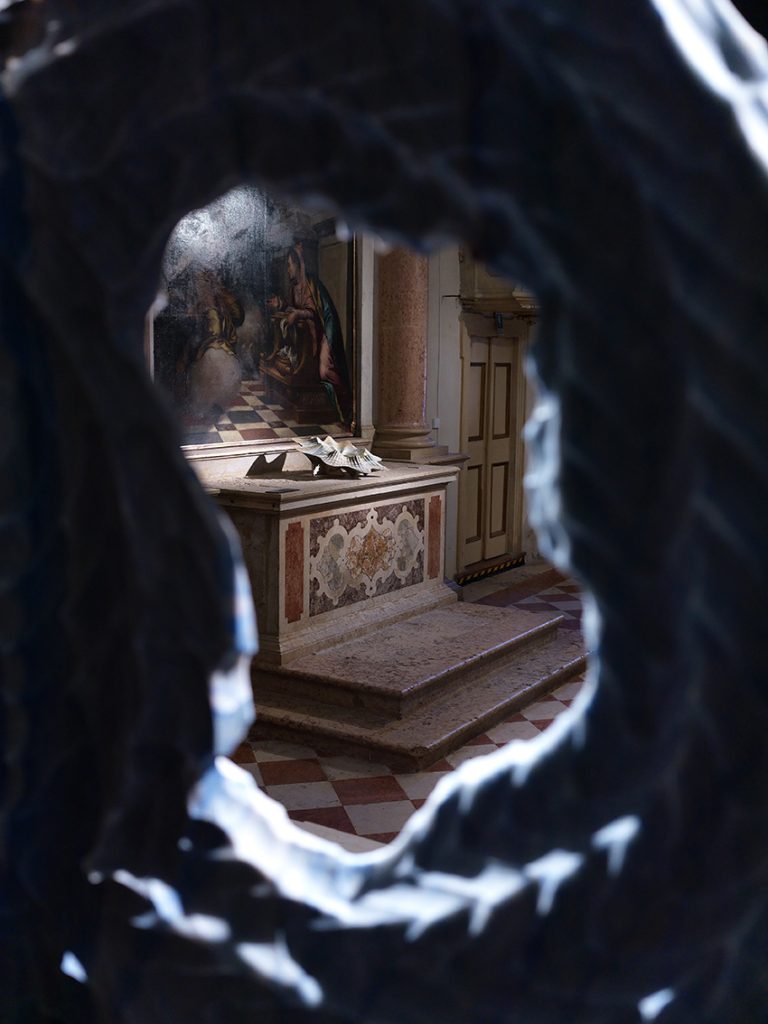
exhibition “ARTEFACTA LAPIS” by Raffaello Galiotto, former church of San Pietro in Monastero, Verona, October 2024 © Raffaello Galiotto
What does Artefacta Lapis mean to you?
Artefacta Lapis is the most recent stage of a long process of research into the expressive potential of marble that I have conducted using computerised tools.
It is not simply a matter of producing works with robots, but rather of using the peculiarities of these software applications in the creative phase, expanding the imagination while at the same time taking into account the ways these machines work, without any subsequent intervention by hand. There is no doubt that even in art, the use of these powerful resources opens up new scenarios, the prelude to new creative opportunities.
The question naturally arises concerning the origin of this fascination for marble, a fascination so profound that it has become a primary element of his artistic production.
I grew up in the Chiampo Valley in the province of Vicenza, an area traditionally known for marble processing, so this material is familiar to me. I did not realise its power immediately but only later, when I was older. Once it is realised that marble is a natural material formed over millions of years, the primordial phases of our planet can then be seen in the textures and infinite colour variations.
The availability of this ancient material and being able to work with it is a great privilege for me, which is why it has become the primary element of my artistic production.
The confrontation between art and technology has long been a feature in the history of art. Walter Benjamin and Marshall McLuhan, among others, have made important contributions in decoding the changing relationship between art, technology and society. Where do you stand on this issue and how is this manifest in your sculptural work? How do you see the relationship between art and technology?
Technology is a means, as were the primordial tools that humanity used to work hard stones. Later, the chisel evolved, eventually becoming a tool guided by software and numerically-controlled precision devices. For me, the use of technology is no longer an issue. I still find the changing and unexpected response of the stone undergoing different processes mysterious and surprising. It should be noted that, in works of natural stone, the ‘aura’ of the work is preserved, as described by Water Benjamin in his essay ‘The Work of Art in the Age of its Technical Reproducibility’, even in the case of automated mass production because, in some way, it can be generated by the stone because the material is itself unrepeatable and authentic. The uniqueness of the work is not only determined by the hand of the artist.
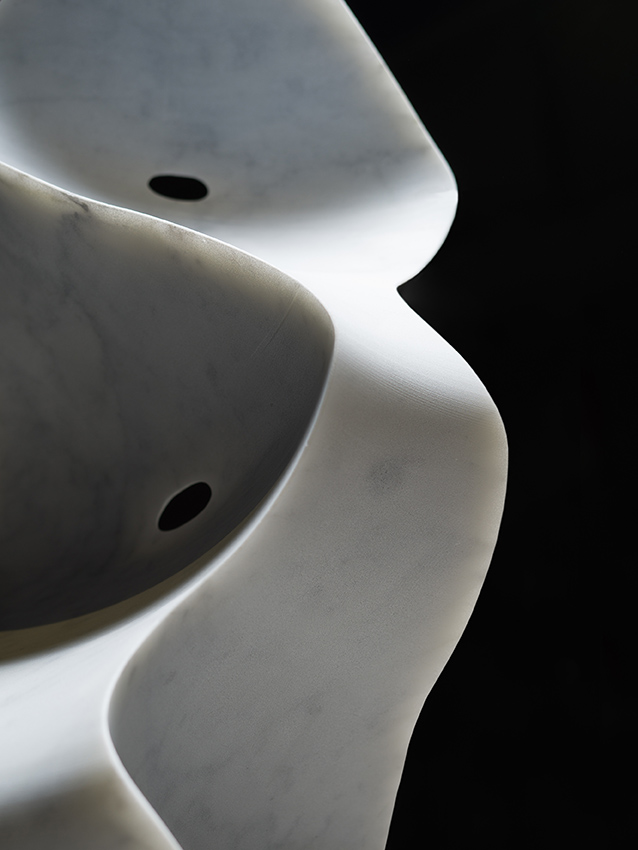
“Perforatum”, 2023. Bianco Carrara marble, 23 x 23 x 98 cm © Raffaello Galiotto
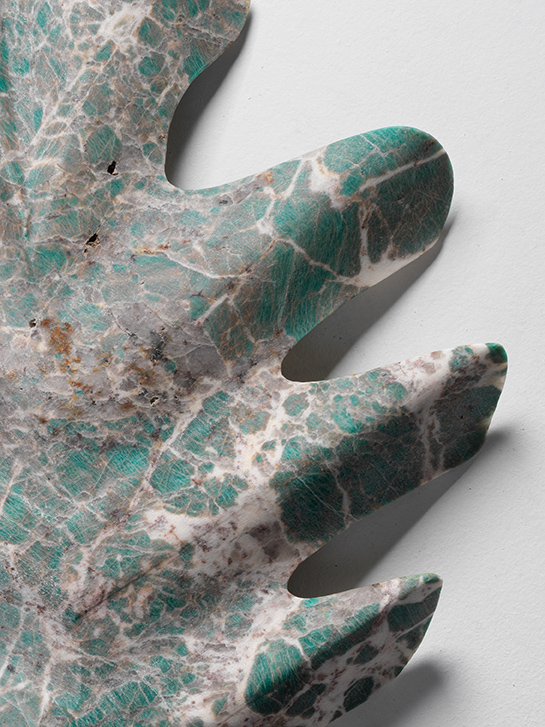
“Quercus”, 2023. Amazzonite marble, 90 x 62 x 11 cm © Raffaello Galiotto
Your artworks are able to communicate lightness, delicacy and grace despite using a heavy and difficult material. Can you describe the entire process, from choosing the marble to the meticulous workmanship, guided by you at every step, before finally attaining the desired result?
Every artwork arises from a precise intent. And for every artwork, both in the creative-design phase and in the execution phase, the limits and characteristics of the material and processing techniques have to be addressed. I love to observe the structures of animals and plants and, through them, with astonishment and a fair degree of incomprehension, I try to work out the logic of the structure and growth. Understanding how the skeleton supports the body, or how a leaf is arranged on a branch, helps me to shape and structure the works in a certain way, removing the superfluous and, at the same time, defining the logic of how they are made. The creative limits sometimes restrict the forms and force me to rethink them before returning and retouching them again and again until I find the solution. This process of elimination, of optimisation, between the initial form and the possible form, is a process that I would say is natural and selective, given that, in nature, nothing happens by chance, and each part depends on the other.
Given that you work closely with technology, have you ever been thwarted because the technology was not yet able to achieve the desired results? How big a role does technological research play in the creation of one of your sculptures?
These artworks are always the result of compromise. There are as many technological limits as there are challenges to overcome. No artwork is simple, each time there is a new problem, be it 3D modelling, the management of machine movements, mechanical collisions, the functionality of the tools and, last but not least, the response of the material. We are at the very beginning of a new era.
The catalogue text and the exhibition were curated by Alfonso Cariolato in a collaboration that produced valuable results. How important for you is an intellectual exchange and another person’s perspective on your artworks?
Comparison and dialogue, especially with the outside world are very important. When you work long and hard on a subject, there is a risk of drifting without even being aware of it. Intellectual input, if honest and direct, can be scathing when it highlights critical issues but, at the same time, it helps you grow and points you in the right direction.

“Transizione I”, 2024. Palissandro marble, 30 x 4 x 65 cm © Raffaello Galiotto
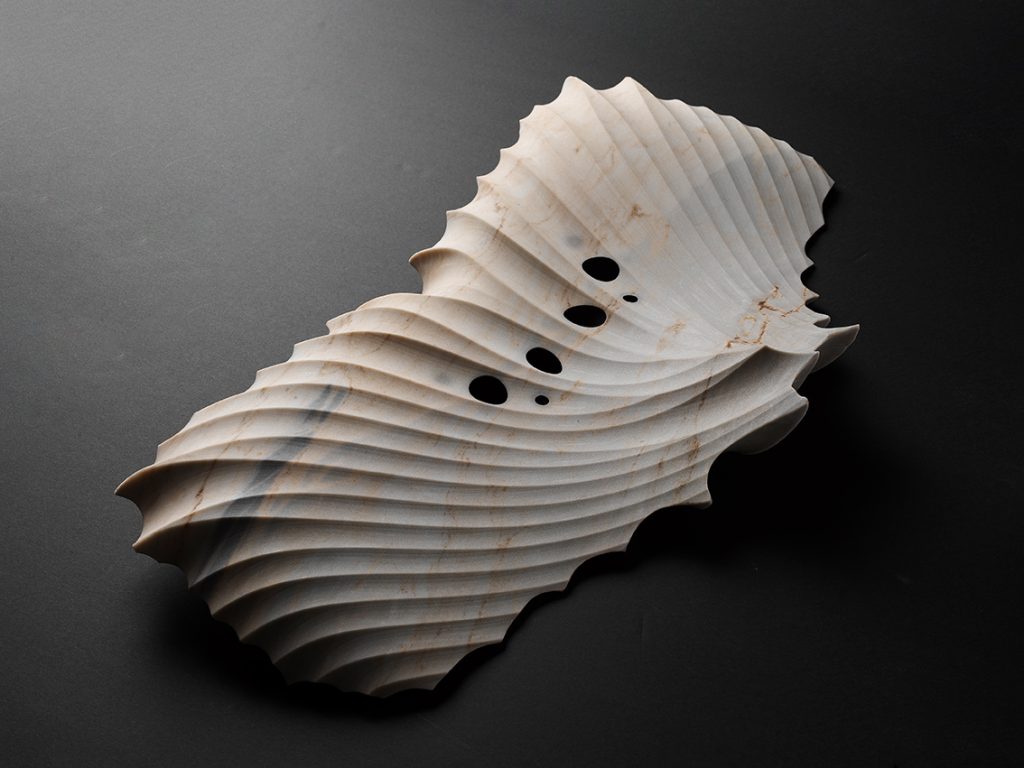
“Transizione IV”, 2024. Palissandro marble , 73 x 8 x 38 cm © Raffaello Galiotto
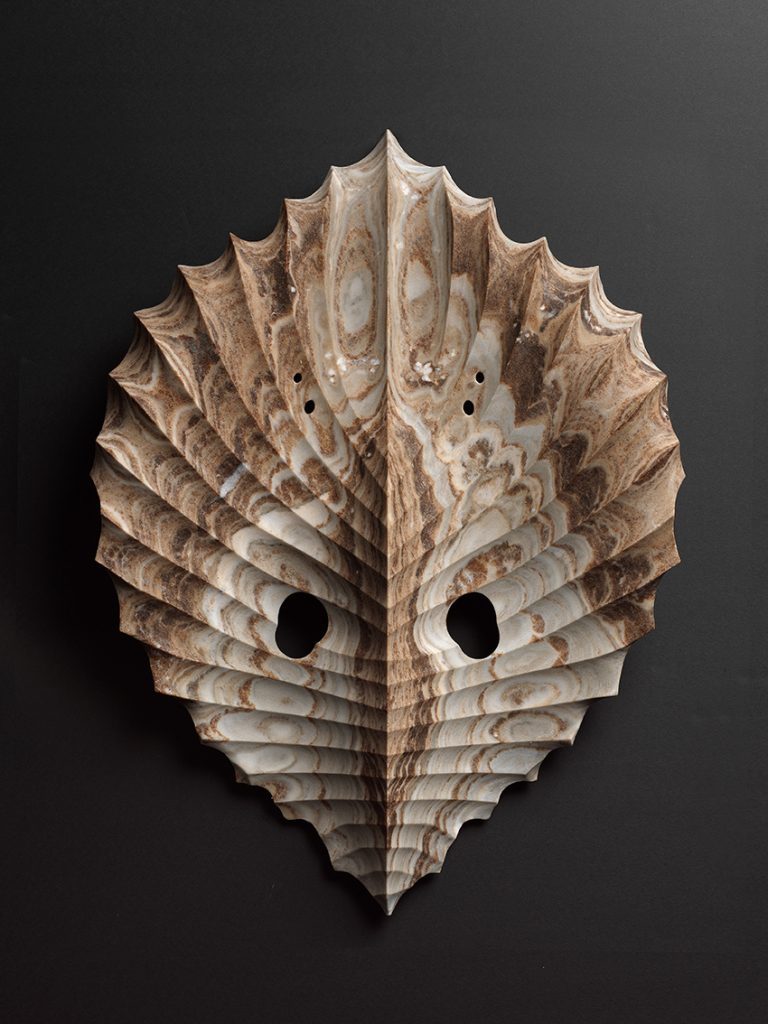
“Transizione V”, 2024. Palissandro marble, 46 x 9 x 65 cm © Raffaello Galiotto
Mostre personali recenti | Recent personal exhibitions:
Artefacta Lapis, Ex chiesa di San Pietro in Monastero, ArtVerona, 2024
Herbarium Mirabile, Marmomac Verona 2023
Next Creatures, ADI Design Museum Milano 2023
Visionary Stone, Marmomac Verona 2022
Creatività e robotica, Fondazione Arkad Seravezza 2016
The Power of Stone, Marmomac Verona 2016
Marmo 2.0, Superstudiopiù Milano 2016
Stonegate, Marmomac Verona 2012 / Piazza Brà Verona 2013 / Chiampo Vicenza 2016
Luce e materia, Triennale Milano 2011 / Material Xperience Utrecht 2017.
Principali pubblicazioni | Major publications:
Artefacta Lapis, Antiga Edizioni, 2024
Next Creatures, Electa 2023
Marmo 4.0, Marsilio 2017
Raffaello Galiotto design digitale e materialità litica, by Veronica Dal Buono, Librìa 2012
www.galiottodesign.it/

